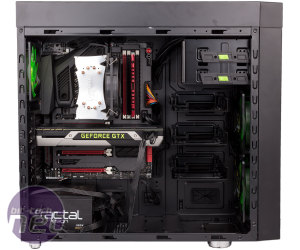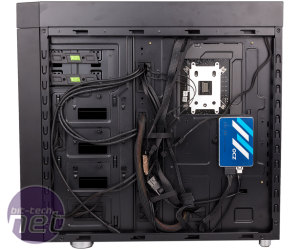
Performance Analysis
A sealed roof usually means that CPU temperatures will be on the warm side, and that's indeed the case here. Even at high speed, the 120mm rear exhaust is only able to maintain a distinctly mid-table delta T of 55°C. In fairness, this is roughly what you'd expect from the test system on an open bench, and it's in line with the maximum speed results of other low-noise cases. The result increases by 2°C with each step of the fan controller, and although the worst case result of 59°C finds the CoolForce 1 quite low down in the charts, it's still 11°C off the worst result we've seen. Anyone buying a case geared towards low noise is likely to accept that temperatures won't be as low as they would be in a more porous case, plus this chassis has ample room to install larger and more effective coolers than we use in order to make up the deficit.The GPU results are actually fairly healthy. We thought the dual intakes would struggle to provide much airflow given how sealed the front panel is, but the small holes obviously do help, and the GPU may also be passively drawing air in through the vents in the bottom of the case. Delta T values range from 47°C to 50°C, so there's little to worry about.
The CoolForce 1 is pretty effective at quelling noise, and our loud graphics card fan was dulled more than we'd normally expect. The case fans themselves are easily heard at full speed; we'd recommend sticking with medium when doing intensive tasks and low when your system is mostly idle.
Conclusion
Positives and negatives seem to abound in equal measure with this case. Take build quality, for example. Certain elements like the steel panels and the core steel interior are pleasing, while others such as the I/O panel, side panel attachment mechanism, roof cover, and dust filters leave room for much improvement. Features like USB 3.1 and fan control are nice to see, but where are the top and bottom dust filters?In short, there's a good selection of ideas here, but the execution isn't always spot on, and the case is let down by a lack of attention to detail elsewhere. There's always give and take when you're looking for a case in this price range, but we came away from the CoolForce 1 a little underwhelmed, especially as Nanoxia has impressed us with its low noise cases in the past. If you're looking for a case designed to contain sound and your budget is £80, it's certainly well worth a look - it is indeed quiet, and the interior is flexible enough to support many different systems. It's far from a disaster; it just isn't quite refined enough to land it in award territory.

MSI MPG Velox 100R Chassis Review
October 14 2021 | 15:04












Want to comment? Please log in.